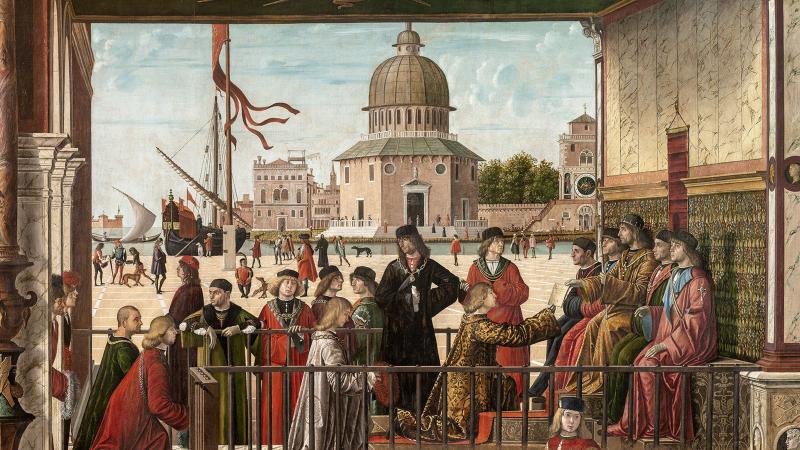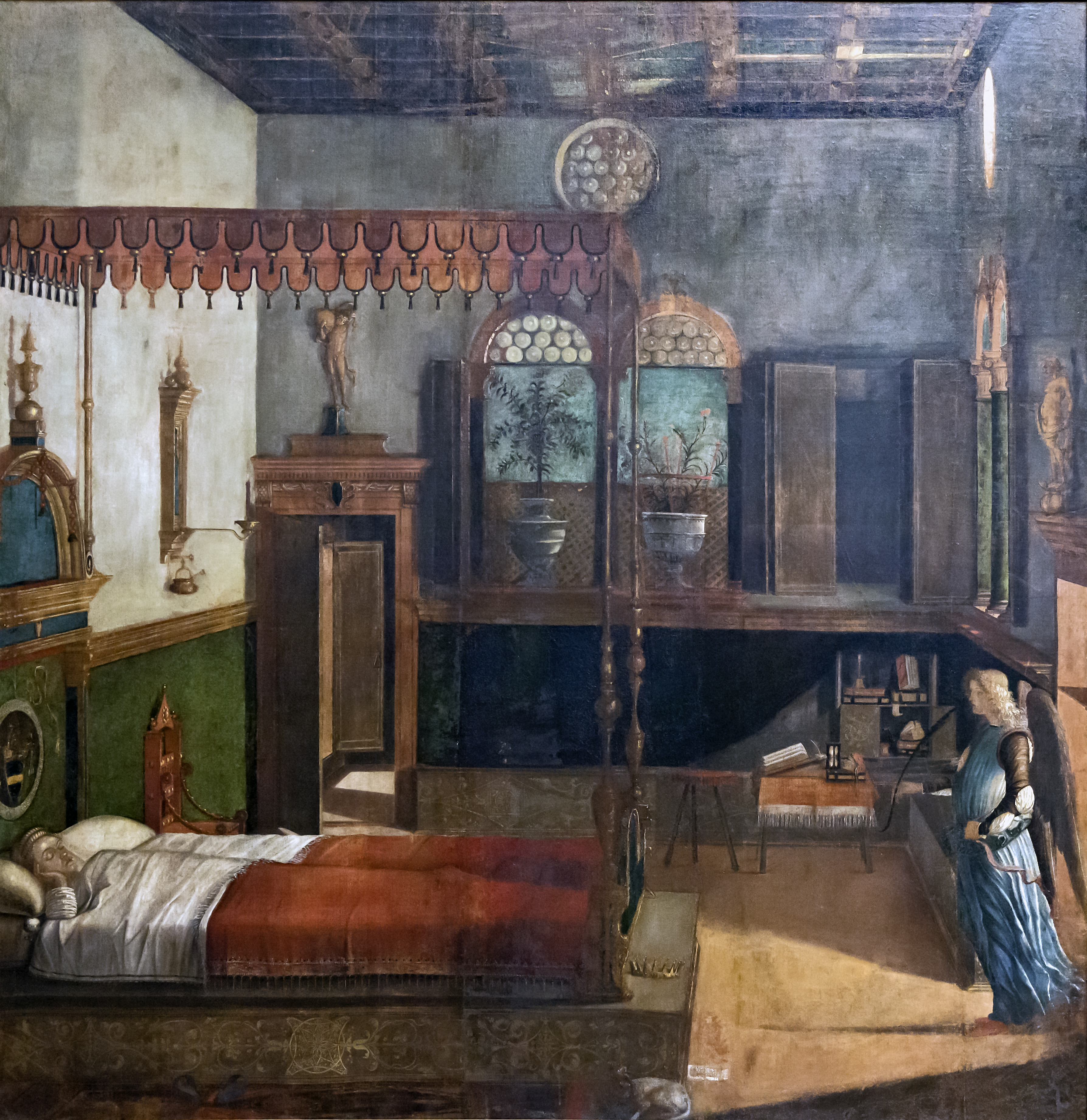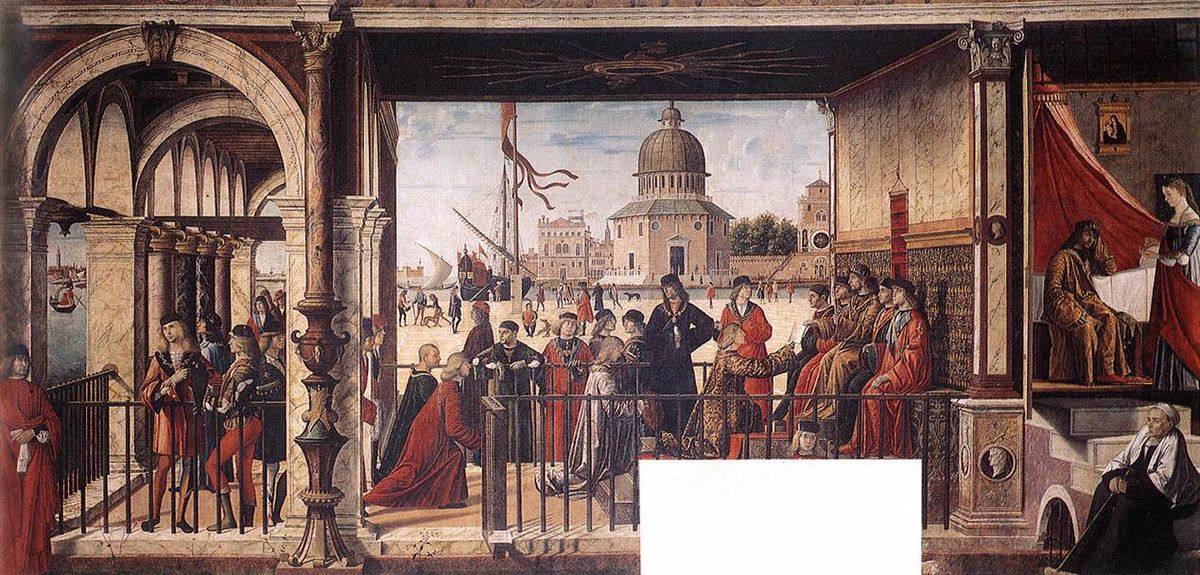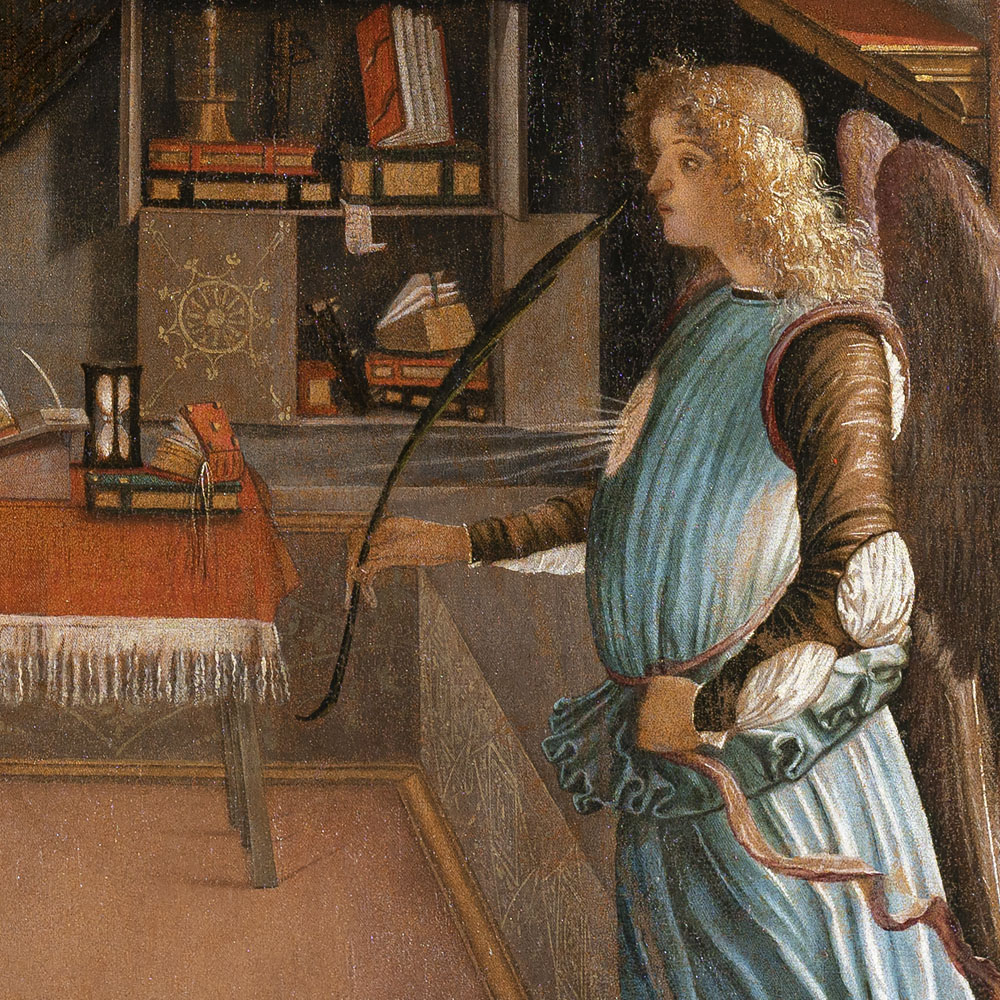
Arrivo degli ambasciatori inglesi presso il re di Bretagna (dettaglio)
One of the great cycles of works to be seen in Venice is the cycle of the Stories of St Ursula. These are nine canvases by Carpaccio made between 1490 and 1495 for the Scuola di Sant’Orsola in Venice and have been in the Gallerie dell’Accademia in Venice since 1812.
Vittore Carpaccio created the cycle with the stories of St Ursula based on the story contained in the Golden Legend by Jacopo da Varazze.
The story tells of the martyrdom of the princess, later to become Saint Ursula, which took place in Cologne in the 4th century AD at the hands of Attila’s Huns. Here’s what you need to know.
Vittore Carpaccio’s cycle of stories of St Ursula

Accademia – Sogno di sant’Orsola – Vittore Carpaccio
It recounts the martyrdom of Saint Ursula and takes place through several works that create a sequence of episodes, allowing the story to be reconstructed as a whole. This feature is also found in the individual works. In fact, many episodes of the Stories of Saint Ursula are described within the same work, from left to right, subdividing the space in an original way and also thanks to the use of light and shadows.
Here are the most important canvases of Carpaccio’s cycle of the Stories of St Ursula.
ARRIVAL OF BRITISH AMBASSADORS TO THE KING OF BRITAIN
In the canvas entitled The Arrival of the English Ambassadors to the King of Brittany, Vittore Carpaccio develops the story in a horizontal sequence of three episodes.
On the left Carpaccio has painted a scene of city life, in the centre he describes the delivery by the ambassadors of the marriage proposal from the prince and Ereo to Orsola, on the right is the conversation between Orsola and her father.
The three scenes are divided by architectural elements, while the central part opens onto a typical Venetian field dominated by a centrally planned church.
Carpaccio describes the story within this canvas as if we were in front of a theatrical performance. Among other things, the psychological depth given to the character of the father in the scene on the right is striking. In fact, Orsola’s father appears almost resigned to the idea of having to accept the conditions set by his daughter for the marriage to take place.
In fact, Orsola does not accept immediately but lays down conditions, namely that the prince convert to the Catholic religion and that together they go on pilgrimage to Rome to the Pope, accompanied by 10,000 virgins.

Arrivo degli ambasciatori inglesi presso il re di Bretagna
THE DREAM OF SANT’ORSOLA
The Dream of St Ursula is one of the most intense works of the entire cycle created by Carpaccio. The format of the work is almost square and the composition is compact AND allows us to understand the symbolic meaning of each element placed within the room depicted.
Orsola, who is in the foreground, is sleeping. The time in which the scene is set corresponds to that of the first light of dawn and an angel, illuminated by the first rays of the sun, enters the room and stops on the threshold.
The angel carries the palm of martyrdom, prophesying his fate. A myrtle plant and a carnation plant can be seen on the window sill: the former is sacred to the goddess Venus and is linked to marriage since, in the Renaissance, it indicated fidelity and eternal love; the latter has a religious and spiritual value since its Greek name means ‘flower of God’.

Sogno di sant’Orsola (dettaglio dell’Angelo)
CHARACTERISTICS AND CURIOSITIES OF CARPACCIO’S STORIES OF ST. ORSOLA
Many episodes of the cycle are set in Venetian public contexts and private spaces, inspired by both the landscape and architecture of the city. Indeed, the buildings of the Clock Tower and Punta della Dogana can be seen, but also the walls of the Venetian Arsenal and many other typically Venetian buildings.
When it comes to interiors, however, Carpaccio seems to be very precise in describing the Venetian home of his time and, for instance, in the ‘Dream of St. Ursula’ the bedroom appears to us as it must have been in a house in Venice in the 15th century.
In the cycle of the Stories of St Ursula there is also a large catalogue of animals, plants and flowers, precisely painted and inserted into the canvases for their symbolic value. There are the flowers of carnation and myrtle in the ‘Dream of St Ursula’, thistle and fern seedlings in the ‘Arrival of the pilgrims under the walls of Rome’, specimens of myosotis around the saint’s bier in the ‘Martyrdom of the pilgrims and the funeral of Ursula’, animals such as the guinea fowl and the monkey in the ‘Return of the Ambassadors’, the dog, the scorpion painted in the flag and the hawk perched on the tree in the ‘Arrival of the Pilgrims at Cologne’, the small dog at the foot of the bed in the ‘Dream of St Ursula’.
Among the figures painted in the canvases are certainly some portraits of personalities of the time, which unfortunately we cannot identify with certainty today. Among them were members of the Confraternity that commissioned the cycle or other important Venetians of the time. In the ‘Arrival of the Pilgrims under the Walls of Rome’, among the figures in the papal procession is the Patriarch of Aquileia Ermolao Barbaro, standing to the right of the pontiff and dressed in a red toga. Behind him, there is a figure dressed in black, which some scholars have indicated as a self-portrait by Carpaccio.
The Gallerie dell’Accademia in Venice, where Carpaccio’s cycle is kept, is certainly one of the museums not to be missed, encompassing centuries of history and art. To learn more about its collections read the page dedicated to everything you can see in Venice, where you can find information on this museum and many others.

